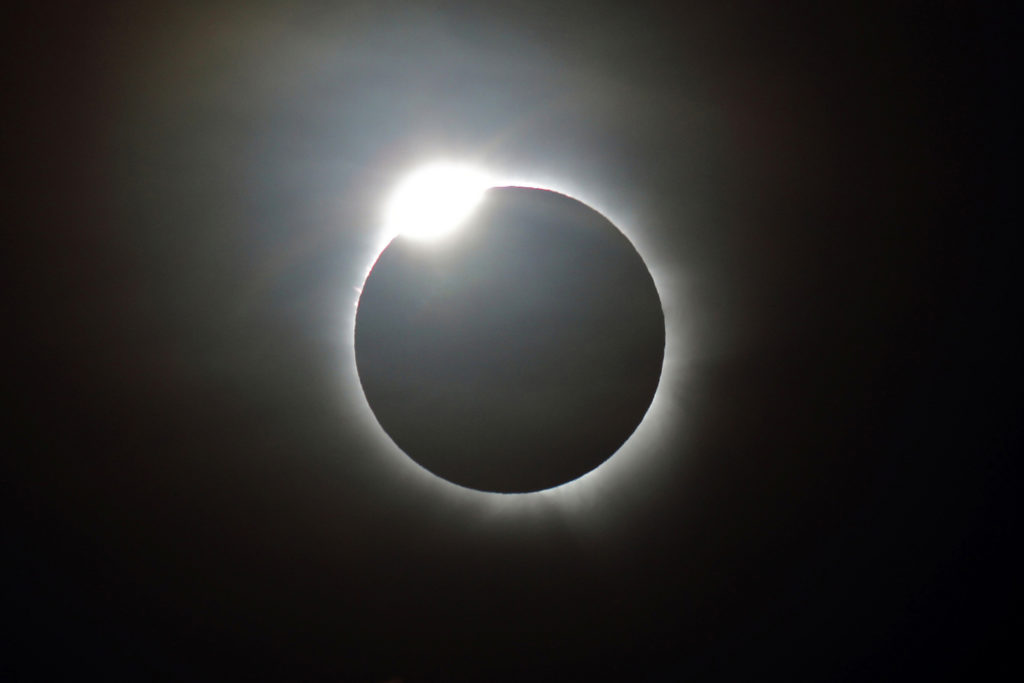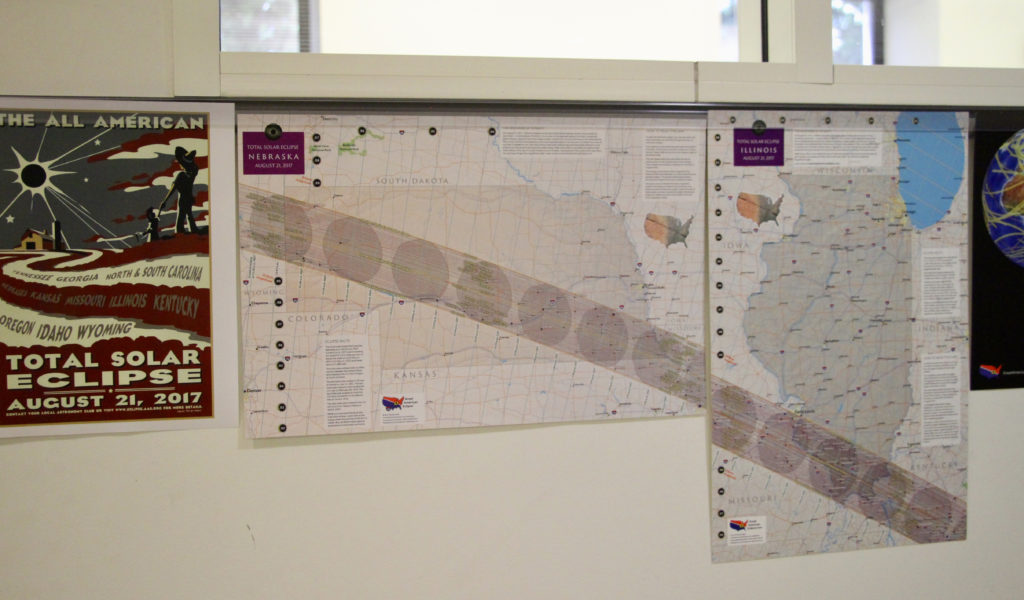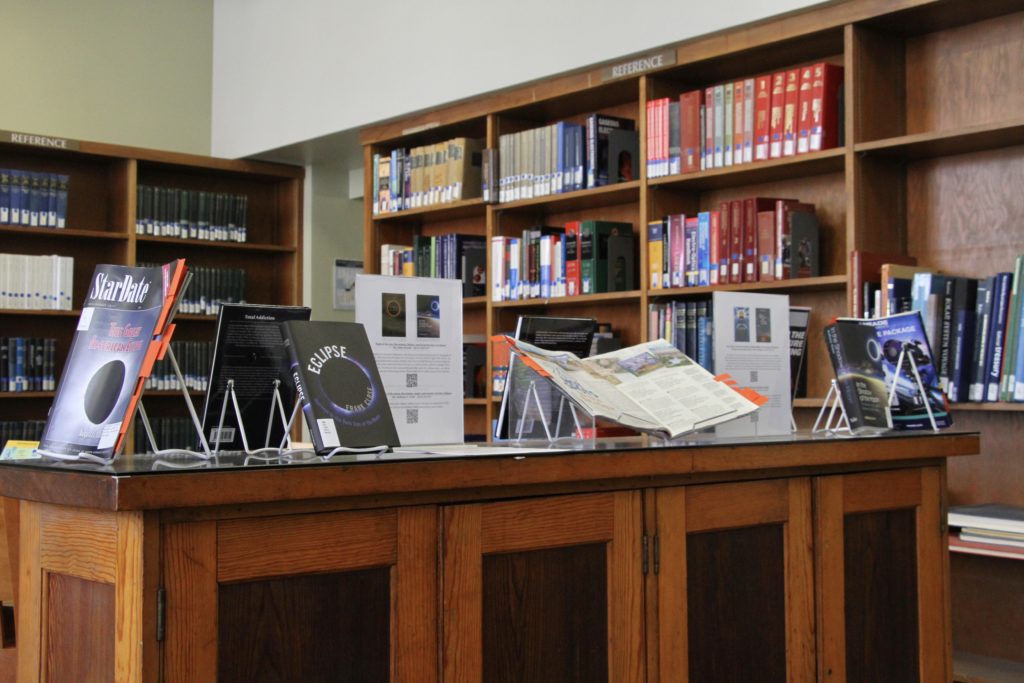
It’s bird! It’s a plane! It’s — an eclipse?
On Monday, the moon will completely cover the sun and cast a shadow across the country, marking the first total solar eclipse visible in the United States since Feb. 26, 1979 — and the first one whose path has traveled from one American coast to the next in 99 years.
Although the forthcoming solar spectacle will be fully visible only from a 70-mile-wide, 3,000-mile-long band — “the path of totality” — which stretches from Oregon to South Carolina, you won’t have to travel far to get your eclipse fix.
Earth and physical sciences librarian Sam Teplitzky, who recently chose the items for a Cal Day eclipse extravaganza in the Physics Library and a Maps and More pop-up event at the Earth Sciences Library, says she has noticed a surge in interest in the topic.
“We’ve had several patrons use the eclipse-related maps to help chart their own eclipse-chasing plans,” she says, “and the new books I purchased related to next week’s eclipse have been checked out all summer.”
Those who can’t make it to the path of totality to witness the full-on phenomenon in person can check out the eclipse-centric displays here on campus. One, on view until Oct. 1, is outside of the Earth Sciences & Map Library (open weekdays from 9 to 5 p.m.), in the lower level of the lobby of McCone Hall. The other, which will be up through the end of the month, is at the main reading room of the Physics-Astronomy Library (open weekdays from 1 to 5 p.m.).


Bonita Dyess, circulation supervisor at the Earth Sciences & Map Library, was instrumental in putting together the eclipse displays.
“I hope people gain a different outlook on our science libraries from looking at our displays,” she says. “I also hope they gain a better understanding of what a total eclipse truly is and how rare this extraordinary event occurs, especially in the U.S.”
We pored over many of the eclipse-related offerings at the Library, full of little-known tidbits and fun facts. Here are just a few things we learned.
1. Eclipse chasing is old.
Heading to Oregon in time for the big event? You’re not alone. Many eclipse enthusiasts are making their way the path of totality — from Boiler Bay in Oregon to Charleston, South Carolina — for primo viewing. But eclipse chasing isn’t new: It is said to have started in 1715. In fact, that year, Sir Isaac Newton created diagrams of the eclipse in England for the public, according to “Total Solar Eclipses and How to Observe Them.”
Interested in the history of eclipse chasing? Rebecca Joslin’s “Chasing Eclipses: The Total Solar Eclipses of 1905, 1914, 1925” tackles the subject, and its beautiful imagery makes it one of librarian Teplitzky’s top eclipse-related picks at the Library.
2. Eclipses come with their own weather.
Like a neighborhood in San Francisco, eclipses are said to come with their own microclimates. Solar eclipses are associated with a drop in temperature — the moon is blocking the sun, after all. Tracking software, however, isn’t sophisticated enough to predict the the weather changes they trigger, according to “Total Solar Eclipses.”
But rapidly fluctuating weather? That’s something all of us in the Bay Area are used to.
3. According to legend, a dragon (or frog or vampire or werewolf or dog) ate the sun.
Eclipses have been explained throughout the years in legends and lore, which vary from culture to culture. The Chinese and Indonesians, for example, historically held that the eclipse is caused by a giant dragon eating the sun, accounting for its apparent disappearance. In fact, the Mandarin word for eclipse is “shi,” which means “eat.”
Eclipse myths involving creatures eating the sun are not uncommon, although the beast ingesting the planets can vary depending on the stories’ origins. In Bolivia, it was a huge dog; in Vietnam, a ginormous frog; a werewolf in Serbia; and a vampire in Siberia, according to the fascinating tome “Total Eclipses: Science, Observations, Myths and Legends.”
4. Eclipses have appeared in many books throughout history — including maybe the Bible.
Eclipses are featured in some of the most highly regarded works in history, including those by Shakespeare (“King Lear”) and Mark Twain (“A Connecticut Yankee in King Arthur’s Court”). Even one of the “Twilight” books is called “Eclipse.”
Most notably, though, is that the Scriptures may depict a solar eclipse. The Bible mentions three hours of darkness in the daytime during Jesus’ crucifixion, according to “Total Eclipses.” But whether this was a religious miracle or a normal (albeit rare) astronomical occurrence — or something else entirely — remains up for debate.
5. Someday, solar eclipses will no longer be visible.
The moon is drifting away from the Earth at a rate of 38 mm per year — which is the thickness of about five iPhones stacked on top of one another. Someday, the moon will appear so small in the sky, it will be unable to obscure the sun, according to “Total Solar Eclipses.”
But don’t worry, chasers — it won’t happen anytime soon.
How to see the eclipse
If you do want to see the eclipse but are stuck in the Bay Area on Monday, fear not: Although the region doesn’t lie on the path of totality, we can catch a glimpse of a partial (or about 75 percent) eclipse — that is, if Karl the Fog is cooperative.
Set your alarm to 10:15 a.m. — or a few minutes earlier, for some wiggle room — so you don’t miss it.
If you don’t end up seeing it in person, of course, there’s the Eclipse Megamovie Project, a crowdsourced venture spearheaded by UC Berkeley and Google, which pulls together volunteer-submitted images of the eclipse from across the country. So, like the sun come Monday, you’ll be covered.
Librarian Teplitzky says, if the weather allows, she’ll likely step outside to look at the eclipse — “with my eclipse glasses,” she adds, referring to the protective eyewear that filters out harmful rays.
You’ll want to nab a pair, even if you’re watching from the Bay Area. After all, you wouldn’t want to risk your eyesight for when the next total solar eclipse is visible in the United States — in 2024.
Sources: ABC Channel 7, American Astronomical Society, “Chasing Eclipses: The Total Solar Eclipses of 1905, 1914, 1925,” NASA, “Total Eclipses: Science, Observations, Myths and Legends”, “Total Solar Eclipses and How to Observe Them,” Washington Post